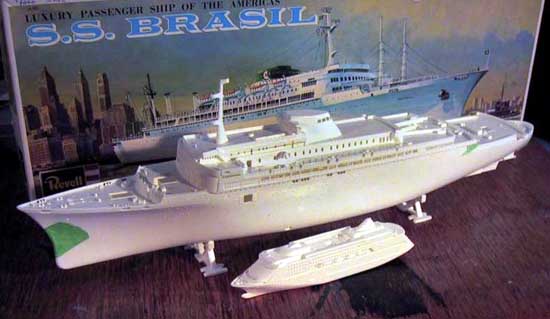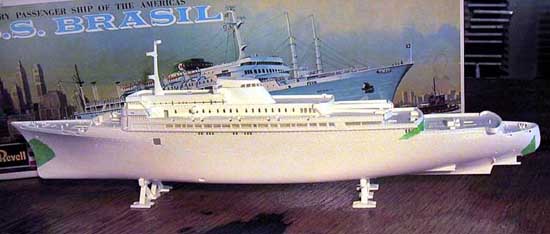
REVELL’s Luxury Passenger Ship Of The Americas ~ S.S. BRASIL
Kit No. H-337
Review by Arjay / Photos by Mike Cook

The major components dry stacked, along side the 1:1200 AIDA for size comparison.
Background: This kit was produced in 1957 (one hatch cover is dated stamped). The assembly instruction’s introduction states: In 1958 ….. (future tense), an indication the development of the kit paralleled the actual building of the liner. The S.S. Brasil and her sister the S.S. Argentina, American designed and American built, were the largest and fastest liners commissioned by the Moore-McCormick Line to serve their New York – Buenos Aires run, each accommodating 553 passengers in one class, and an important selling point at the time, air conditioned comfort. Both are still in service today, somewhat rebuilt (although recognizable) and re-named. In fact, I believe they just may hold the record for the number of name changes during their respective careers. And speaking of names, why ‘Brasil’ and not ‘Brazil’? According to Bill Miller (Pictorial History of American Passenger Liners) the Portuguese spelling was at the request of the Brazilian government of the day.
General Information: This kit has been out of production for some time, however it does make an occasional appearance on ebay. The kit I was fortunate to acquire, via an estate sale, is a 1975 German re-issue. Typical of most Revell ship models it is molded in white plastic. The hull is two halves (mirror images, thus I can not vouch for architectural accuracy in terms of number and placement of ports / windows), and features molded railings. Railings can be removed and replaced by P/E components, if one prefers. A minor irritant: bulkheads, for the most part, are molded ‘split’, the lower half attached to the deck with the upper half to the deck-head above. However, the seam (when the pieces are pressed tightly together) appears to be much cleaner and less noticeable compared to the same of Revell’s Queen Mary.
Overall Dimensions: This kit, owing to its larger scale, is an appealing size. From bow to stern she measures approximately 18". Although the actual scale is not indicated on the box (or instructions) this equates to 1:400 (+/-). She measures 2.5" in width and 3.25" from bottom to top of the funnel structure. The radar mast, forward, is slightly higher.
Instructions: Provided on one large 16.5" x 22" sheet, printed both sides. Typical of kits of this era the graphics (some of the best I have seen) are supported by written instructions. Being a German re-issue the paint recommendations have been translated from English. However, the paint’s numerical references can easily be cross-referenced via the paint conversion charts posted on the Debris Field. Of benefit, rigging is indicated on the instructions although I suspect it may be somewhat simplified compared to was actually featured on the liner.
Decals: The kit supplied a small sheet of water-slide decals featuring the ship’s name, deck games, draught marks and funnel logo. Given the passage of time (the kit was opened), I was fortunate to find the decal sheet still in the box, if somewhat curled and yellowed. Whether they will be salvageable remains to be seen. A nice touch is the patches of aqua-green foil to represent the water of the two open-air swimming pools, but not the children’s splash pool. I am somewhat surprised the decal sheet did not offer the ‘ss Argentina’ option. (I have recently came across a reference to a separate ‘Argentina’ kit, however I believe this claim is bogus.)
Review: All things considered this is one gem of a kit, one of the better in my collection. I am impressed by the level, and crispness, of molded detail, even on smaller components such as davits, featuring rivets and guide-wire gears. Even the brackets supporting the Promenade Deck overhang are featured. Flash is minimal and assemblies dry-fit / snap together tightly, with only a few obvious seams to be addressed. The hull features scribed paint lines, and the majority of hull, and superstructure, windows are molded open (including those of the inboard Promenade Deck bulkheads, representing what I believe to be the true architecture within). The hull does feature minor sinkholes, easily corrected. Portholes and gangways are molded raised. A novel touch is the two open hull gangways, each featuring a pair of shell doors against the hull. Accommodation ladders (with handrails), to be attached to the hull, are included, as well as the protective ‘propeller’ cages. As the open gangways allow one to ‘see through’ the hull, vestibules should be scratch-built inboard if one decides not to plug these openings (which will necessitate the removal of the hull doors). Unique to the ships’ design was the ‘funnel pavilion / solarium’, glazed forward and aft. Although short lived it did give the vessel a distinctly futuristic appearance, a forerunner (and perhaps also the inspiration) of the RCCL funnel lounges to come.
Difficulty: Although not rated, in my opinion this kit would rate a ‘two’, based on the AirFix rating of 1 – 4 (most difficult). As noted the assembly instructions are easy to follow and there are few ‘small parts’. Advanced modeling skills are not a prerequisite to build this kit; thus it could easily be completed with a couple of weeks effort. Although are not extensively documented, Moore-McCormick was a regular advertiser in National Geographic; thus issues between 1958 – 1960 could prove valuable in providing photographs of ship and decks, prior to conversions.
Conversion Possibilities: If so inclined one could convert her to represent one of her rebuilding and livery (like Holland America). However, this is something I would only consider doing to a second kit, if I were fortunate to obtain one. Her design ‘as is’ is too eye-catching to spoil.
Issues: Two have already been noted: the split bulkheads (adding clear, or colored acetate behind the open windows could be problematic), and the solid railings. As for the railings one should put things in perspective. In 1957, a time before the availability of after-market products, a kit without railings would probably have been considered incomplete. One alternative to removing, and replacing with P/E components, could be to paint the inboard surfaces, and the outer (carefully between the rungs) a festive color such as yellow / buff, green or blue. It is not uncommon for ships to have canvas lashed to the inside surfaces of their railings to serve as windbreaks; thus, a splash of color could create this illusion. The other issue is deck scribing. I have yet to determine the actual surface material, yet if the passenger decks were planked then the model’s scribing (like Revell’s Oriana) represent sheets of plywood. I suspect the lines may actually represent welded seams. Additional research is required.
Rating: Apart from the issues noted above it is difficult to seriously fault this kit. Its larger scale provides a level of detail not normally featured at 1:600; and the ship’s warm-water ‘liner / cruise ship’ design is most appealing. This is one kit Revell should be encouraged to re-issue (I have already posted a letter), provided the molds still exist. I give this kit an overall score of 9 out of 10.

Full-bodied, yet racy. Note ‘open’ hull gangway.
Arjay ~ 10/03